Registered with the Registrar of Newspapers for India under R.N.I 53640/91
Vol. XXV No. 21, February 16-29, 2016
The city’s major reservoirs
by Sudha Umashanker
A short series on the lakes of Madras
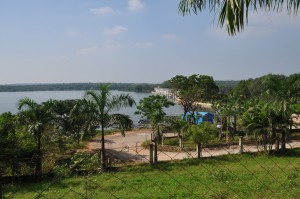 Pondi Reservoir (Satyamurthi Sagar) and Park.
Pondi Reservoir (Satyamurthi Sagar) and Park.
If there was one good thing about the Chennai floods it is this: It showed us exactly where all the long forgotten and badly brutalised lakes are. The price we paid for filling up lakes and building over and around them was steep and the effects devastating.
Looking for the lakes two months after the floods is like going on a treasure hunt. Though the city has plenty of water bodies, big and small, some people are either blissfully ignorant or indifferent about their existence, importance or their names and often point to many others than the ones you are looking for. Anyone looking for a lake is eyed with a lot of suspicion and asked questions “Eri paarkanuma yaravathu aalai paarkanuma? Vari ezhutha vandirikeengala?” (Do you want to see the lakes or do you want to see someone else? Have you come to collect taxes?)
Given the general ignorance and confusion I wouldn’t have located many of the little known lakes but for Google Maps and GPS. The bottom line is there are far more lakes than we can imagine in our city and it is imperative that we create greater awareness and save them without delay.
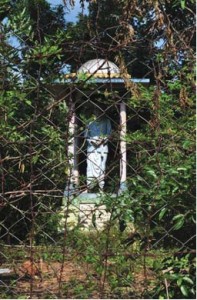
Statue of S.Satyamurthi ill-remembered.
The best place to start would be the major reservoirs that supply water to the city
As we drove along Poonamallee High Road, past Tiruverkadu past a sign board that says Thirumazhisai, there is another insignificant looking one that directs the searcher to Chembarambakkam. Since we overshot it, we retraced our steps and an elderly man from the village told us to take the lane next to a little Ganesha temple. The car struggled on that battered road along the lake, lined on either side by scrub forests and fencing trees (veli kaathan). A signboard warning people not to bathe or fish in the waters was all faded and rusty. Despite the warning not to, we saw a few people washing clothes by a little wash area just off the road.
Chembarambakkam, 40 km from Chennai, is a vast expanse. It is one of the rain-fed reservoirs from where the south of Chennai gets its water. Chembarambakkam was once known as Puliyur Kottam and was one of the 24 kottams, or villages, that existed in the later Chola period in Thondamandalam which had Kanchipuram as its capital. Back in those days it irrigated about 168 villages. It has trees and vegetation dotting it here and there, apart from posts carrying high tension cables. After the release of water from Chembarambakkam and the flooding of the city, the reservoir attracts the odd, curious visitor who comes by to check out what the lake looks like.
Poondi was the next stop.
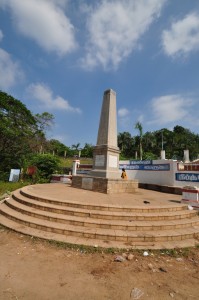
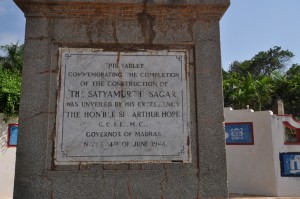
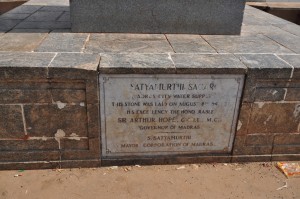
Satyamurthi better remembered with obelisk and foundation and completion plaques.
From Poonamallee High Road we took the Tirupati/Tiruvellore Road, past the Othandeeswarar Koil Tank and Chennai Public School and drove through fertile stretches, watching the birds flying above. We took a right turn at Tiruvellore Collector’s office to get to Pullarambakkam and Satyamurthi Sagar.
If I had to choose a scientifically designed and well preserved water body it would be the Satyamurthi Sagar (Dam and Lake). To get to the lake you need to drive down a few levels on well-maintained roads with hairpin bends. En route there is a small statue of S. Satyamurthi, largely hidden by the vegetation. Satyamurthi, a legal luminary who played an active role in the freedom struggle and went to jail for it, was known for his integrity, honesty and his oratory. He was one of the key members of the Indian National Congress from Madras Presidency. He was also a Mayor of Madras from 1939 to 1943. It was during that term that Madras was struck by a famine and the onus was on Satyamurthi to place the proposal of the Madras Corporation before the British Government for building a reservoir at Poondi. The project was completed in record time, but Satyamurthi did not live to see it commissioned.
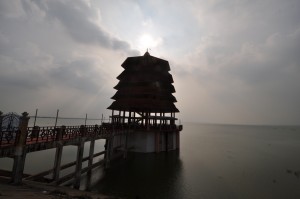 Chembarambakkam.
Chembarambakkam.
The tablet commemorating completion was unveiled by Governor Arthur Hope on June 14, 1944. It was K. Kamaraj who got this dam named after Satyamurthi, his mentor. Even the TNCC office at Chennai is named Satyamurthi Bhavan. An obelisk gives all the historical details. Next door is the Institute of Hydraulics and Hydrology. A few random visitors, including monkeys, were in the vicinity. The lake is a joy to behold. From Poondi water is distributed through a system of link canals to other storage reservoirs located in Red Hills, Sholavaram and Chembarambakkam. We stopped by briefly at the Pullarambakkam Neer Oondu Nilayam (Water Booster Station) on our way out.
Leaving Poondi past the Tata Steel stockyard, we chanced upon Thiruninravur and caught sight of the lake from the bridge. A closer view was more difficult as we were told to go down a kind of (underground) tunnel which turned out to be a narrow street. As we drove out we could see that some of the houses in Thiruninravur were still water logged.
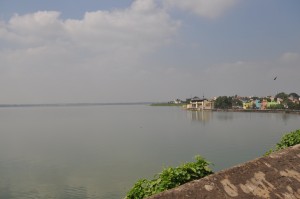 Red Hills Reservoir (All pictures by the Author).
Red Hills Reservoir (All pictures by the Author).
Cruising along on the Red Hills Road, Ambattur, we spotted huge blocks of stone besides the giant water pipes as we caught a first glimpse of the lake opposite Velammal institutions, Omayal Achi College of Nursing and several warehouses and spare parts dealer showrooms. Even as we were wondering how construction was allowed so close to the lake (the lack of urban planning is so in your face), a left turn on to the highway past the arched entrance of Puzhal Jail took us to the Red Hills reservoir. What greeted me as soon as I alighted from the car was a massive mound of garbage that had caked up just opposite and not too far from the eri (on a second visit, these open lorries parked and the mound of garbage had reduced somewhat). Why anyone would do that is beyond me but in Chennai that is precisely how it is. It seems as if landfills, eris and lakes are meant to co-exist.
Climbing up a few steps, we caught a glimpse of this vast sheet of water glimmering and glinting in the sun. Red Hills is from where North Chennai gets its water supply. It is a rain fed reservoir built by the British in 1876. Originally a small tank, its capacity was increased many times over to meet the demand and also to store Krishna water from Andhra Pradesh received through Poondi and Sholavaram tanks. The watch tower at Poondi is known as the Jones Tower. Built in 1881, it helps to measure the depth of water in the lake.
Not far from here is the Rettai Eri, Ambattur, desilted in part. We could spot a lone man in what looked like a toy boat negotiating the waters.
(To be continued)

